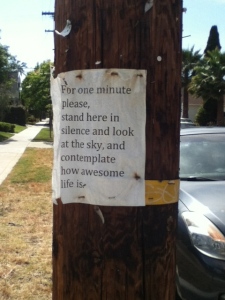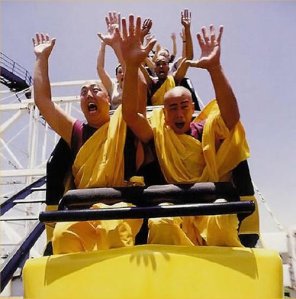I was out for a walk in my neighborhood, grooving to some tunes on my headphones and lost in my head, when I saw this poster on a telephone pole:
It stopped me in my tracks. I was pleased and amazed that some mystery person had taken the time to remind his neighbors to be mindful. It was a refreshing change from the usual garage sale and lost cat posters, and I liked that it had rusty staples like it had been there awhile, anonymously encouraging people as they passed by.
And so I stood there, trying to do what the sign said. Boy, one minute can sure seem like a long time, I thought, feeling anxious to get back to my Daft Punk. I’m not sure if I can spare one minute. I don’t want my heart rate to come down, I explained to myself.
They say that if you if you don’t have time to meditate, you should just do a practice for 20 minutes. And if you don’t have 20 minutes, you should meditate for an hour. How apt.
I continued on my walk, observing how difficult it was to take even just one minute out of my whole day, just one of 1,440 minutes.
Then I moved house, and all my minutes got jumbled up, my usual routines and practices all went out the window for a few days. In the chaos I kept thinking about that mystery sign, how I should just take one minute to press pause, look up at the spacious sky, and take in the wider view. Remind myself of the fleeting nature of the moving experience, and that there were constants I could find all around me.
I started a new little mantra: Just Take One Minute. When I felt myself getting overwhelmed with my “gotta do’s” or rushing about town, I stopped and did nothing but breathe for one minute. Instead of jumping in the car and simultaneously setting the iPod, sipping water, putting on lip gloss, buckling the seatbelt, fishing for a mint in the glove box, putting on sunglasses, singing, punching in directions to the phone, AND backing out of the driveway, I just stopped for one minute before doing anything else. And breathed. THEN I started the process of backing out and driving, and I noticed that I was more prone to do one task at a time, and that I was more aware and engaged in the task at hand: driving.
So I invite you to try this simple little practice. Read to the end of this paragraph, and then stop everything for one minute and just feel yourself breathing. Without changing the breath, just notice what it feels like. Then at the end of the minute, notice how you feel overall. Has anything changed? How can you use this practice to help you manage your life?





